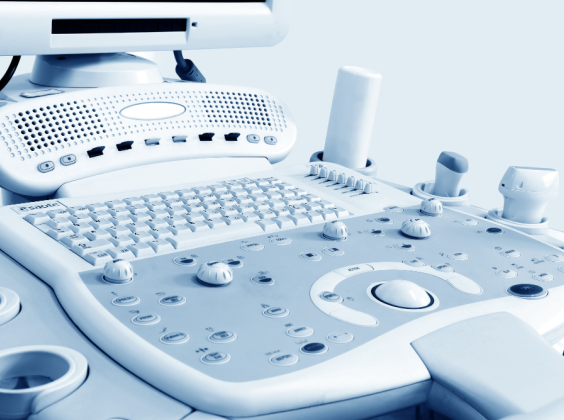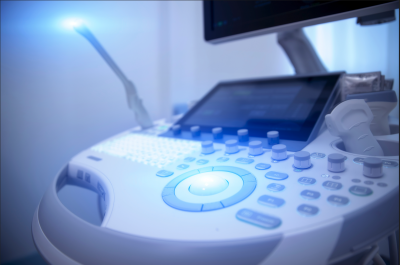
Written by

Cranfield, UK, 20th October 2022 – The pace of innovation continues to be strong in the ultrasound market, in particular product development has been centered around performing ultrasound examinations outside of traditional settings. This is important as it keeps patients out of the hospital, which is not only preferable for the patients, but also saves the hospital money. It also enables problems to be detected earlier and is a more efficient means of monitoring patients with chronic conditions.
Several vendors are looking to take ultrasound out of traditional settings, including Caption Health, which in June 2022 launched Caption Care, a home heart wellness assessment service. Caption Health also partnered with Portamedic, Inc., to enable its mobile technicians to use the Caption AI platform to perform cardiac ultrasounds in patients’ homes. This follows an announcement by GE Healthcare, in May 2022, of its $50 million investment in Pulsenmore, whose flagship product allows expectant mothers to use their own smartphones to conduct ultrasound examinations on themselves in a home setting.
These two market developments show that the wheels are now in motion for performing ultrasound examinations in the home setting. Whilst the wheel is moving slowly at present, Signify Research predicts increased uptake in the upcoming years. But this raises several questions; who will be the users of ultrasound in the home? Who will pay? What other barriers will need to be overcome?
The patient or the practitioner?
For ultrasound devices to be used at home, the biggest question that needs addressing is who will actually perform the procedure? Will it be the patients themselves? Or will it be healthcare practitioners?
If it is the patients themselves, then they will need the required training in order to obtain high quality ultrasound images. Ultrasound is a difficult imaging technique to learn, but AI solutions have been developed to assist in probe guidance to accurately obtain ultrasound images. For example, UltraSight, who received CE mark approval in August 2022 for its UltraSight guidance solution, provides the ultrasound operator real-time instructions on how to manoeuvre the ultrasound probe to capture diagnostic quality cardiac ultrasound images. There are similar regulatory approved solutions available from other vendors like Medo.ai and Caption Health.
Trained professionals are well placed to perform scans in the home, as they know the technique and have access to portable ultrasound devices. The use of handheld ultrasound is expanding as it is easier to perform scans outside of the hospital, due to its compact size and portability. This is the easiest route to enabling use of ultrasound in the home but also has more limitations; having trained clinicians travel to many patients is not as efficient as many patients going to one clinician. It is unlikely there will be a large scale roll out of clinicians travelling to patients’ homes for scanning. More likely, it will be for more high-risk and vulnerable patients, such as the elderly, where travel to access an ultrasound scan may not be possible.
Who will pay?
Compact ultrasound system prices range from around $10,000 to over $60,000, depending on the system type. Even the cheapest compact systems in this range are far too expensive for consumers to use in the home. The development of handheld ultrasound is most certainly a significant step in the right direction, but with the lowest priced handhelds costing around $2,000, this is still too expensive for patients to purchase themselves or for providers to give to patients.
For home healthcare workers the cost of the ultrasound system is less important, as it will be purchased by the healthcare provider and given to the healthcare worker to use. The bigger factor will be the choice of ultrasound system to be used in the home. The choice between whether a compact or handheld system is used will be a balance between the portability and technical capability they require.
For patients to use the devices in the home, the cost will need be in the hundreds, not the thousands. Pulsenmore has a docking device costing several hundred dollars that can pair with a mobile phone for ultrasound scanning. There are also ultrasound patches, like those developed by engineers at MIT, which capture ultrasound images using a simple patch that is stuck on the skin. The patches, which are the size of a postage stamp, can provide continuous ultrasound imaging of internal organs for 48 hours and maintain strong adhesion during various activities, such as sitting, standing, jogging, and biking. When these patches obtain regulatory approval, it could eliminate the one of the biggest barriers to patients scanning themselves at home – performing the procedure.
Whether it be a device or a patch, for patients themselves to use ultrasound in a home setting, the big question is who will ultimately pay for it? It is highly unlikely that the patients will pay themselves. So, for the home ultrasound market to grow, it will need to be paid for by another party. This will for the most part be insurers and is one reason that Pulsenmore is working with Clalit Health Services in Israel, a fully integrated healthcare insurer and provider. It is also possible that pharmaceutical companies could pay for ultrasound to be performed in a home setting, if it means more patients will take their drugs.
The tangled web of regulatory approval
Regulatory approval is a lengthy process and varies from country to country. In some countries there is guidance, primarily in obstetrics, for pregnant women to not perform ultrasound scans at home. As the procedure will be done by the women themselves, and not by a certified professional, potential abnormalities may be missed which increases the risk to the baby and expectant mother.
Whilst recent product introductions into obstetrics, such as by Pulsenmore, differentiate themselves as a clinical device rather than an entertainment product, market education will be needed to reassure customers of the benefits of doing the scans at home. This has been accelerated by the COVID-19 pandemic, where as a result of the lockdowns, patients are now more accustomed to having medical appointments at home. A big driver in getting the use of ultrasound in the home approved, is the subsequent cost savings for hospitals by reducing the number of routine appointments and false alarm visits to the ER, by having the patients scanned at home instead.
The Signify view
Being non-ionising and lower cost than other imaging modalities, ultrasound is well suited to be used in the home. Signify Research believes that ultrasound will enter the home market, but the timescale and route in which this happens at a large scale is yet to be determined. Whilst the scans being performed by the patient themselves is the ideal scenario, in the short term we expect a combination of solutions to enter the market that enable ultrasound scans to be performed by both patients and trained experts, as demonstrated by Pulsenmore and Caption Health.
What will also impact how ultrasound is used in the home is in the application it is used for. In obstetrics, where pregnant women may need a scan at any time if fetal movement is not felt, or if they need occasional routine scans to track health of the mother and baby, it is more feasible to have the patient scan themselves, rather than have the women go to the hospital. For monitoring of cardiac diseases, which would be more regular and complex, this can be achieved with clinicians visiting the patients’ at home, keeping them out of the hospital. Although again the longer-term goal is for patients to scan themselves.
Whilst ultrasound patches are far from ready for market adoption, when they are, it could lead to scenarios where patients use them to monitor themselves to detect early signs of disease, infection, rehabilitation or physical training, assisted by AI solutions. These could eventually be a substitute for clinicians to scan patients at home, and instead monitor the patch remotely. What is important is that the use of ultrasound in the home by patients is carefully monitored by healthcare professionals to ensure that potential health dangers are not missed.
Establishing a new ultrasound market, much like building a house, takes time. For the burgeoning home ultrasound market, the foundations have been laid, and now is the time for building works to commence.
About Signify Research
Signify Research is an independent supplier of market intelligence and consultancy to the global healthcare technology industry. Our major coverage areas are Healthcare IT, Medical Imaging and Digital Health. Our clients include technology vendors, healthcare providers and payers, management consultants and investors. Signify Research is headquartered in Cranfield, UK. To find out more: enquiries@signifyresearch.net, T: +44 (0) 1234 436 150, www.signifyresearch.net
More Information
To find out more:
E: enquiries@signifyresearch.net
T: +44 (0) 1234 436 150

